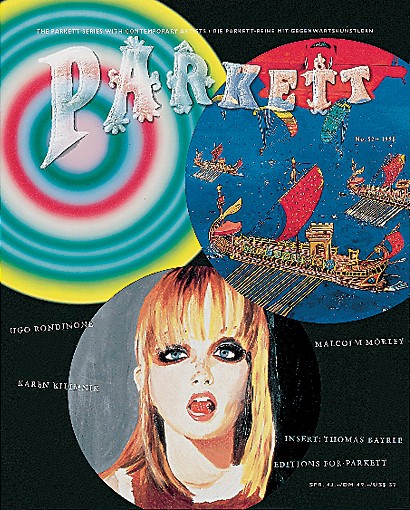
Soft Cover, German, Thread Stitching, 264 Pages, 1998
Parkett No. 52 / 1998
availability unknown, if interested please write an email
GRIDS AND SPRING TIDES. The network or the grid, which had already served Dürer, plays a declared role in Malcolm Morley’s paintings.
Morley’s remarks tell us, not without self-irony, how indispensable they are to his work. In his finished pictures, however, the grid is not merely invisible; it seems as if the painting process had attacked and dissolved it from within—like a spring tide. For the past decade, Malcolm Morley has been driven by the idea of flow, of colors crashing in on us, of remembrance, psychic realities and the adventurous excitement of blissful childhood. Morley first discovered the cells and atoms of his constructions, or “gems,” as he calls them, in the dedicated act of painting from a source during his photorealist phase. He began to take “forbidden” painterly delight in these particles, lending spatters of paint a startling dynamics, and subsequently endowing the excesses themselves with meaning. In Thomas Bayrle’s Insert, the network itself begins to vibrate, giving rise to a cellular life of an entirely different order. The spine has been designed by Sylvie Fleury. Ugo Rondinone also makes us think in terms of cells: the cell as a cocoon in which the artist has encapsulated himself in suspended animation as if in a trance, while the storm rages all around him. In his Edition for Parkett, all moments stop here and together we become every memory that has ever been, he has felt his way into the innermost being of perfectly formed river-bed stones, in the name, as it were, of humankind. The Polaroid photographs each accompanying the stones (and taken in the artist’s personal surroundings) relieve them of the onus of abstract purity, for they are thus immersed in the personally experienced aura of banality that envelops everyday life. As a whole the photographs form a grid, an ordered system, that has risen out of today’s impure world. When Karen Kilimnik draws, paints, or assembles her objects, she devotes herself to the emotional world that floods out of the sluices opened daily by the tabloid press. It is as if she were trying to test the veracity of this global spring tide, by liberating it from the interference of the fake rationale that ordinarily keeps it in check.
Language: English/German






























